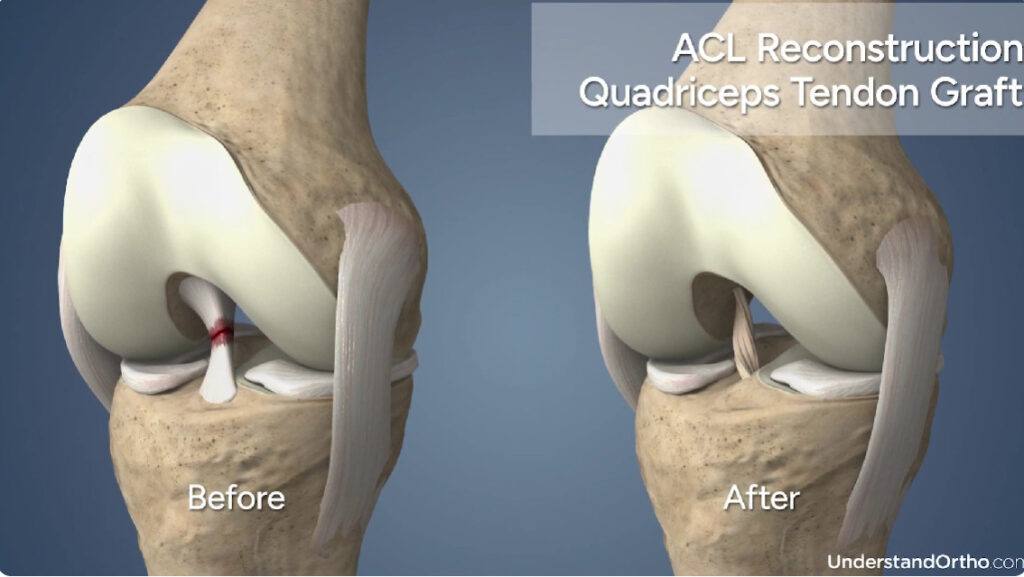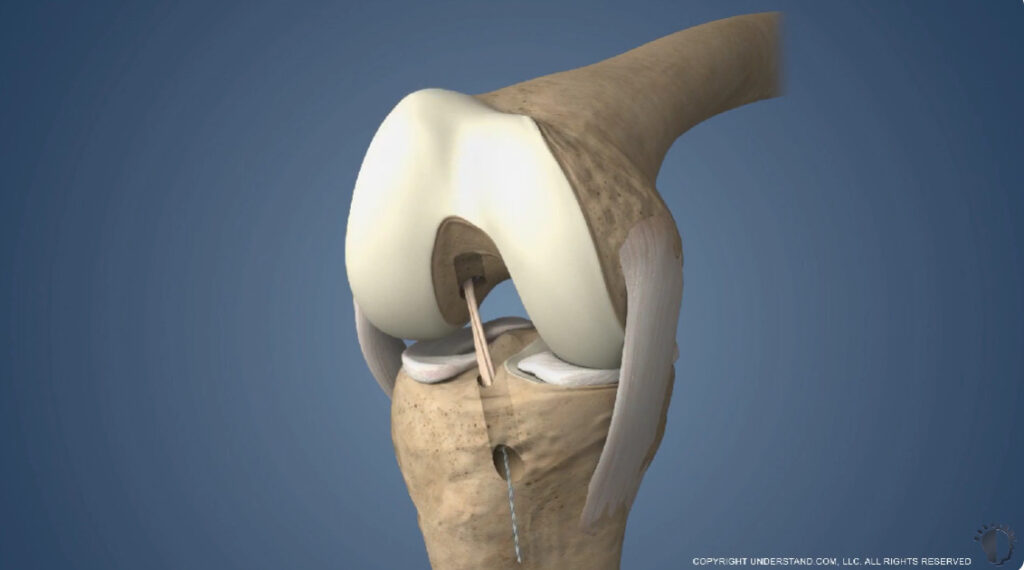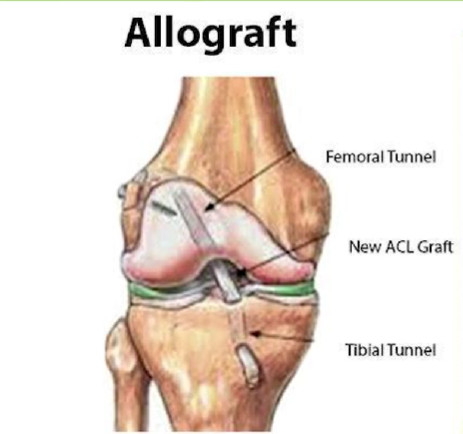Introduction
ACL injuries are a frequent challenge for athletes, often necessitating surgery to regain knee stability and functionality. A pivotal choice in the ACL reconstruction journey is selecting the right graft type.
This guide we will delve deep into the various ACL graft options, including autografts (patellar tendon, quadriceps tendon, and hamstring tendon) and allografts. We will provide you with detailed insights into the advantages and disadvantages of each option.
No matter your sport—be it soccer, basketball, baseball or weekend activities—understanding these graft options will empower you to make a well-informed decision tailored to your specific athletic requirements. Ensuring your graft is suited to your sport and lifestyle.
Autografts vs. Allografts
Before diving into specific graft types, it’s essential to understand the difference between autografts and allografts:
- Autografts: These grafts are harvested from your own body. The three main types are the patellar tendon, quadriceps tendon, and hamstring tendon grafts.
- Allografts: These grafts are taken from a cadaver (donor) and used to replace your damaged ACL.
Patellar Tendon Graft
The patellar tendon graft is one of the most commonly used autografts in ACL reconstruction, especially for high-demand athletes involved in sports requiring frequent cutting, jumping, and pivoting.

Pros:
- Strength and Stability: The patellar tendon is robust and provides excellent initial stability, reducing the risk of graft elongation and failure.
- Familiarity: Many surgeons are highly experienced with this graft, leading to reliable outcomes.
Cons:
- Anterior Knee Pain: Patients often experience pain at the front of the knee, particularly when kneeling.
- Long-Term Issues: There is a risk of developing chronic patellar tendonitis or anterior knee pain.
Rehabilitation Tips:
- Quad Strengthening: Focus on building quadriceps strength to support the knee.
- Soft Tissue Work: Regular scar massage and soft tissue mobilization can help reduce pain and improve flexibility.
- Isometric Exercises: Incorporate exercises like wall sits to strengthen the knee without overloading the patellar tendon.
Quadriceps Tendon Graft
The quadriceps tendon graft involves harvesting a portion of the quadriceps tendon, which is a strong and thick tendon located just above the kneecap.

Pros:
- Less Anterior Knee Pain: This graft tends to cause less anterior knee pain compared to the patellar tendon graft.
- Strength: The quadriceps tendon is robust, providing excellent stability.
Cons:
- Muscle Shutdown: Post-surgery, the quadriceps muscle may shut down, requiring intensive rehabilitation to regain strength.
- Scarring: There is a risk of developing scar tissue at the harvest site.
Rehabilitation Tips:
- Early Quad Activation: Use electrical stimulation and blood flow restriction therapy to activate the quadriceps early in the rehabilitation process.
- Progressive Loading: Gradually increase the load on the quadriceps to rebuild muscle strength and size.
- Explosive Training: Incorporate plyometric exercises in the later stages to enhance explosive power.
Hamstring Tendon Graft
The hamstring tendon graft is often used in female athletes or those with less robust quadriceps muscles. This graft involves harvesting a portion of the hamstring tendons.

Pros:
- Minimal Anterior Knee Pain: Patients typically experience less pain at the front of the knee.
- Less Invasive: The harvest site tends to heal quickly with fewer complications.
Cons:
- Hamstring Weakness: Post-surgery, the hamstrings may be weaker, impacting activities that require hamstring strength.
- Delayed Loading: You must avoid loading the hamstring for the first few weeks post-surgery.
Rehabilitation Tips:
- Hamstring Strengthening: Focus on closed-chain exercises like hip bridges and hip thrusts early in the rehab process.
- Deceleration Training: Emphasize deceleration and change-of-direction drills to improve hamstring function and prevent future injuries.
- Proper Mechanics: Ensure proper sprinting mechanics to reduce the risk of hamstring strain.
Allograft
Allografts are sourced from cadaver donors and are typically used in older patients or those who do not want to endure the additional trauma of harvesting a tendon from their own body.

Pros:
- No Donor Site Morbidity: There is no need to harvest tissue from the patient’s own body, resulting in less post-operative pain and quicker recovery.
- Simplified Surgery: The surgical procedure is often shorter and less invasive.
Cons:
- Graft Rejection: There is a small risk that the body may reject the donor tissue.
- Weaker Graft: Allografts may not be as strong as autografts, leading to a higher risk of re-rupture.
Rehabilitation Tips:
- Focus on Strength: Prioritize strengthening the quadriceps and hamstrings to compensate for any potential graft weakness.
- Monitor for Rejection: Be vigilant about signs of graft rejection, such as excessive swelling or pain.
Choosing the Right Graft: Factors to Consider
Selecting the appropriate ACL graft depends on several factors:
- Sport and Activity Level: High-impact sports may benefit from the robust stability of the patellar tendon graft, while less demanding activities may suit the hamstring or quadriceps graft.
- Previous Injuries: Consider any previous knee injuries or surgeries that may impact graft choice.
- Surgeon’s Experience: Consult with your surgeon about their experience and success rates with each graft type.
- Personal Preferences: Discuss your goals, concerns, and preferences with your surgeon to make an informed decision.
If you want to learn more about the graft options, check out this video:
Check out our other videos as well to help you with your recovery journey.
Conclusion
Choosing the right ACL graft is a crucial step in your journey to recovery and returning to your sport. Each graft option has its advantages and disadvantages, and the best choice depends on your specific needs, activity level, and goals.
By understanding the differences you can make an informed decision that aligns with your athletic aspirations. Always consult with your surgeon and physical therapist to develop a personalized rehabilitation plan that will help you return to your sport stronger and more resilient than before.
Remember, the ultimate goal is not just to recover but to enhance your performance and prevent future injuries.
How We Can Help You
If you’re still unsure of what path to take with your ACL surgery, we are here for you!
At Myokinetix, we specialize in guiding athletes all throughout the recovery process, particularly when it comes to ACL tears. This expertise is the core of our practice, and we’ve successfully assisted countless athletes in making informed decisions tailored to their unique needs, type of play, and goals.
Our dedicated team will work closely with you, understanding your specific requirements and focusing exclusively on your recovery journey. We are committed to helping you not only recover but also return to your sport stronger and more resilient.
Trust Myokinetix to provide the personalized care and expert guidance you need to make your recovery a success.
Book a call with our patient development coordinator now and discover how we can be your partner to a successful and faster recovery.
